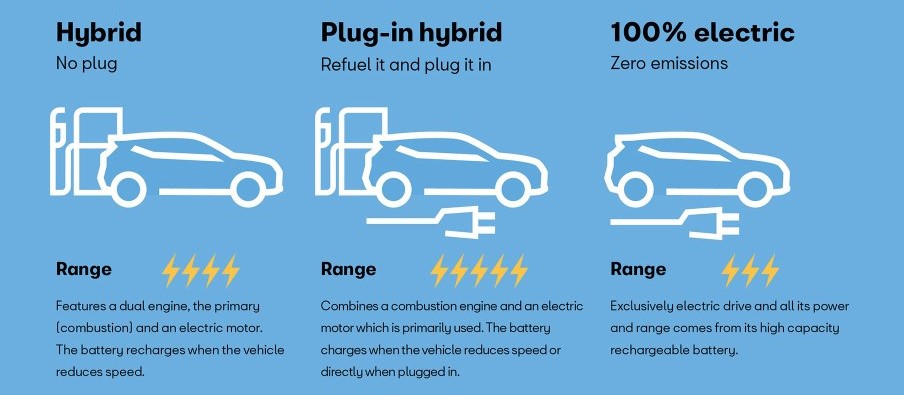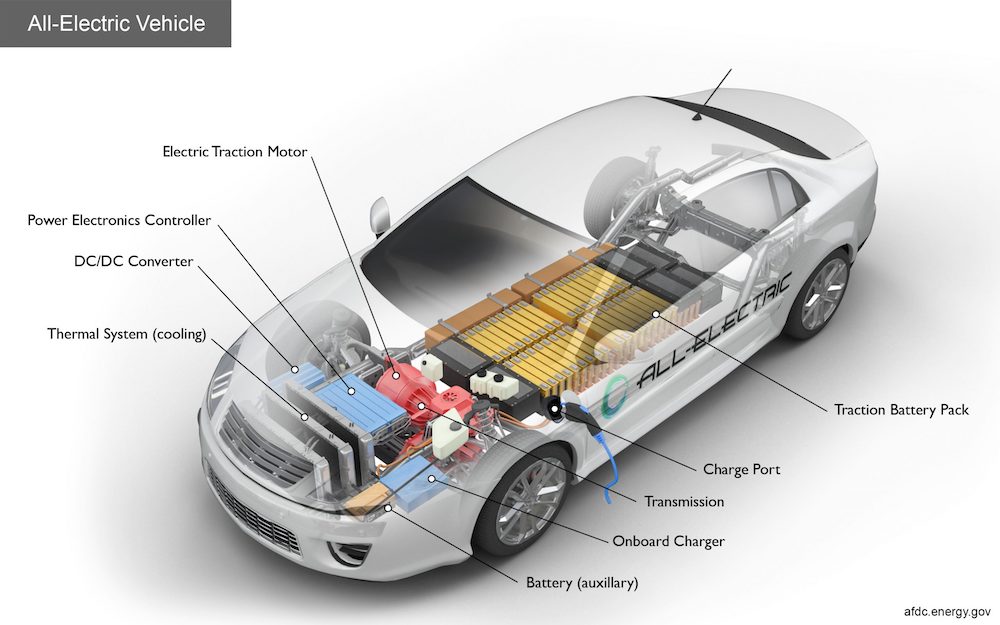Driving electric is easy, fast, quiet, and better for the environment. Interested in learning more?
Drop down each question box to learn more, or contact a coach if you have a specific question. We want to give you the full picture of what driving electric is really like!
How do electric vehicles work?
Curious about how an electric vehicle works? Check the link on the image on the above for more details about the EV diagram and be sure to watch the video below the image for some great insight into what’s going on when you drive an EV.
How long does it take to charge?
- Level 1 charger (120v, regular electrical outlet in your home): 4–6 miles of range per hour of charging
- Level 2 chargers (240v outlet in your home or many public chargers): 20–40 miles of range per hour of charging
- Fast-charging stations: deliver 150 to 500+ miles of range per hour.
Charging is affordable, too! EVs measure fuel efficiency through kilowatt-hours (kWh) per 100 miles. Kilowatt-hours are measures of electrical energy, and EV users generally pay less per mile than the drivers of gas-powered vehicles. The most common mix of charging results in paying the equivalent of 80–85 cents/gallon. Click here for more information about charging.
Are EVs better for the environment?
EVs run more efficiently, have no tailpipe emissions, and produce fewer emissions overall.
EVs run much more efficiently than gas cars. In fact a report by the International Council on Clean Transportation (ICCT) found that 'emissions over the lifetime of average medium-size BEVs registered today are already lower than comparable gasoline cars by … 60% — 68% in the United States' (ICCT Report, 2021).
Additionally, all fully electronic vehicles have zero tailpipe emissions, so you are not actively polluting when you drive compared to a gasoline powered car.
Everyday the grid is getting cleaner and more efficient. As technology continues to advance and alternative forms of energy increase in usage, the grid will produce less and less emissions. Electric vehicles will overall produce significantly fewer emissions than gas cars.
EVs also produce little to no noise, reducing noise pollution on our roads.
EV Safety
EVs have a lower center of gravity than gas-powered cars, meaning they’re less likely to roll over in the event of a crash. Check out these EV crash test ratings to see for yourself. They're also heavier cars and have better handling around turns.
In addition, reduced or zero emissions also mean that EVs facilitate cleaner, safer, and healthier air for us to breathe, and contribute less to transportation-related air pollution. The Environmental Defense and the Ontario Public Health Association found that this improvement in air quality from just one electric vehicle would yield $10,000 in social benefits.
Types of Electric Vehicles

Just as there are a variety of technologies available in internal combustion engine (or ICE) vehicles, electric vehicles have different features that can accommodate the various needs of different drivers. A major feature of EVs is that you can plug them in to charge from an electric power source. This distinguishes them from hybrid electric vehicles, which supplement an internal combustion engine with battery power but cannot be plugged in. EVs measure fuel efficiency through kilowatt-hours (kWh) per 100 miles. Kilowatt-hours are measures of electrical energy, and EV users generally pay less per mile than the drivers of gas-powered vehicles. There are three basic types of EVs: hybrids (HEV), plug-in hybrids (PHEV), and battery-electric vehicles (BEV). BEVs are also known as all-electric vehicles (AEV).
A hybrid electric vehicle (HEV) is a combination of an electric motor and a traditional internal combustion engine but does not plug in to an electric outlet. The primary source of power is gasoline, with the electric motor supplementing to add fuel efficiency. These vehicles are not a focus of Drive Electric Colorado and are not included in any of the current tax credits and incentives. Example: Toyota Prius.
A plug-in hybrid electric vehicle (PHEV) is a combination of an electric motor and a traditional internal combustion engine, and the electric motor is the primary source of power. If the battery range is depleted, the ICE will kick in, so you can get to your destination to charge your battery for your next trip. Some people prefer PHEVs because of this “back up” option that effectively negates range anxiety. PHEVs plug into an electric outlet to get charged, and are included in most tax credits and incentives. Examples: Chevy Volt, Toyota Prius Prime, Mitsubishi Outlander.
A battery electric vehicle (BEV) runs on electric motors that get power from a large battery that is charged by plugging the vehicle into a power source like a wall outlet in your garage, or a public charger. BEVs do not use an internal combustion engine at all. Examples: Nissan LEAF, Chevy Bolt, all Tesla vehicles. In addition to charging from the electrical grid, both PHEVs and BEVs are charged in part by regenerative braking, which generates electricity by capturing the energy that is lost when braking in ICE vehicles. Curious about how regenerative braking works? Scroll below for a more detailed explanation!
Benefits of Electric Vehicles
SAVE TIME

- Charge overnight at home – leave home every day with a full charge, no more stopping at gas stations
SAVE MONEY
- Lower maintenance costs because there are fewer parts to service, no oil or other fluid or belt changes
- Electricity is less expensive than gas
GO GREEN
- No tailpipe means no harmful emissions when you drive
- Reduced exposure to benzene and other volatile organic compounds at gas stations and in your home
PERFORMANCE
- Instant Peak Torque: Maximum power when you step on the pedal *Disclaimer: this power can be dangerous and drivers should be cautious*
- Regenerative braking
- More responsive driving
- Agile, quiet ride
Driving Electric in Colorado
Preparing to drive in the winter months is important here in Colorado. Here’s what to expect and some tips for driving electric vehicles in the winter. You can also read our blog post, ‘5 Tips for EV Driving in Colder Weather.’

Extreme cold impacts range
-
- Passenger heating requires more energy and therefore drains the batteries – sometimes up to 50%!
- Cold batteries have a resistance to charging and do not hold a charge as well
Technology is improving
-
- Battery heaters pre-condition your batteries to more efficiently accept and maintain a charge
- Your EV has software that can schedule charging completion for the time of your departure to warm up the batteries right before you drive
Tips for successful EV winter driving!
-
- Eco-mode helps with battery conservation
- Use your seat and steering wheel heaters. Keeping the HVAC off will significantly help conserve the battery.
What it Feels Like to Drive an EV
Does driving an EV really feel all that different from what you are used to with your gas or diesel vehicle? Read over the driving qualities of EVs below to get an idea of what to expect, then go try one for yourself! You deserve to experience it for yourself.
- EVs have what’s called “instant peak torque” – or maximum speed available immediately. This is because fossil-fueled vehicles operate at about 30 percent efficiency, and about 70 percent of the energy is eaten by heat, sound, friction and pollutants that are destroying our atmosphere. A vehicle powered by an electric motor can operate at about 90 percent efficiency, according to Fuel Economy’s Vehicle Energy Efficiency report, because of instant power through torque and regenerative braking (Vehicle Energy Efficiency, n.d.)*. (Check out this video for a techie description of why this is a great feature of EVs.)
- Electric vehicles use “regenerative braking” to slow and stop the car. Moving vehicles have a lot of kinetic energy, and when brakes are applied to slow a vehicle, all of that kinetic energy has to go somewhere. On fossil-fueled vehicles brakes are solely friction based and the kinetic energy of the vehicle is wasted as heat when a car is decelerated. All of that energy is simply lost to the environment as waste heat. Regenerative braking (or regen) uses an electric vehicle’s motor as a generator to convert much of the kinetic energy lost when decelerating back into stored energy in the vehicle’s battery. Then, the next time the car accelerates, it uses much of the energy previously stored from regenerative braking instead of tapping further into its own energy reserves. Regenerative braking will feel different than what you’re used to; in fact, you may find you rely much less on the brake pedal. Many EVs have the capability to control the level of regen when you drive to a point that you are comfortable with.
- Dual motor all-wheel drive (AWD) options with advanced traction control are available in many vehicle models. The term “dual Motor” refers to the vehicle having two electric motors – usually one over each axle – to provide power from the battery to the wheels to move the vehicle forward.
- Many electric vehicles – especially those purpose built to be electric (not modified from previous gasoline cars models) have the battery pack at bottom of the vehicle. This increases rigidity of the frame which increases safety by making it difficult to roll the vehicle and providing a solid base. It also centralizes the weight of the vehicle which makes for better handling.
- Electric vehicles are very quiet because battery power and electric motors do not have the noise making exhaust systems like internal combustion engines do. In fact, electric cars are so quiet that auto manufacturers are required to add artificial motor sounds to electric cars when traveling at low speeds to alert pedestrians. In many cases you can choose the sound that you want your car to make!
*Fueleconomy.gov. n.d. Vehicle Energy Efficiency. [online] Available at: <https://www.fueleconomy.gov/feg/pdfs/ElectricVehicleEfficiency.pdf> [Accessed 8 February 2021].
Interactive Tools
Use these interactive tools to help you understand more about EVs!
Home Charging Advisor: Find chargers and incentives for charging your electric car at home (by zipcode)
eGallon: Compare the costs of driving with electricity
Carbon Counter: Evaluate your car model against greenhouse gas targets




